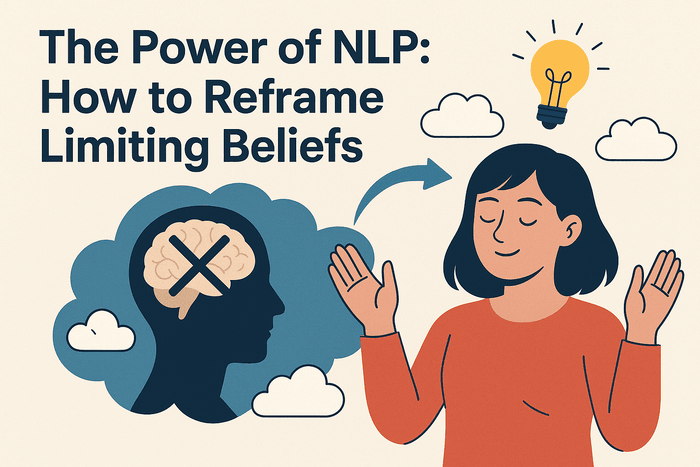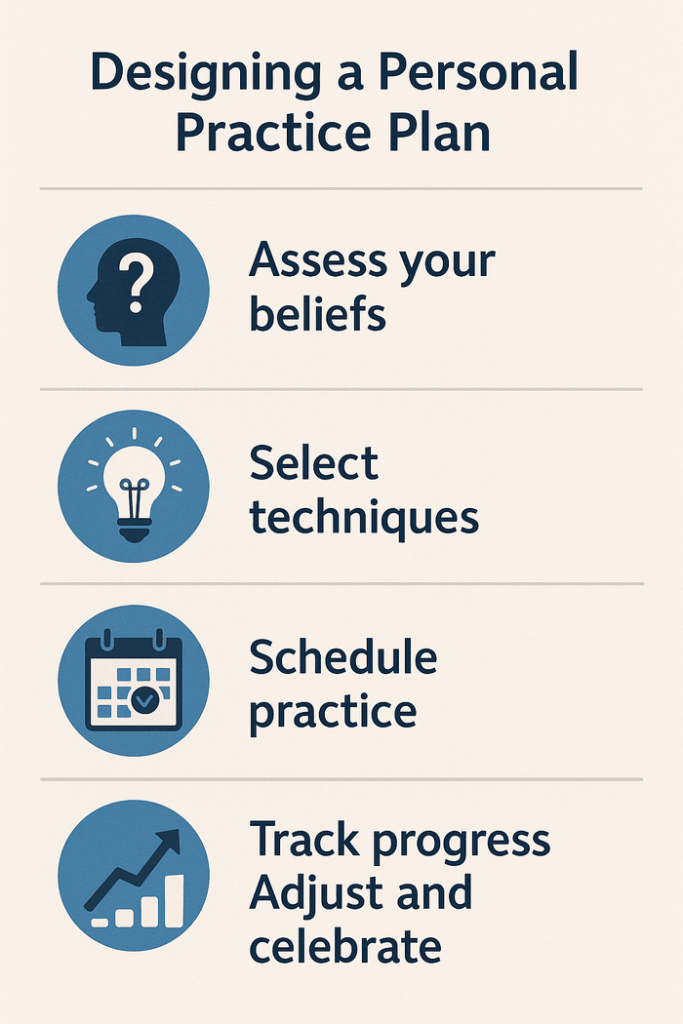
When searching for a certified life coach program price, it’s natural to start by comparing tuition fees. Aspiring coaches want...
Thoughts shape reality. When you believe you’re not good enough, not smart enough or not deserving of success, your actions and results often reflect those beliefs. These limiting beliefs act like invisible chains, constraining your potential and shaping your self‑image. The good news? Beliefs are not fixed. Neuro‑Linguistic Programming (NLP) offers powerful tools to identify, challenge and reframe the internal stories that hold you back. This extensive guide explores what limiting beliefs are, how NLP works, and practical techniques to help you rewrite your narrative and unleash your power.

Limiting beliefs are deeply held assumptions about ourselves, others or the world that restrict our choices and capabilities. They often sound like “I’m bad at public speaking,” “Money is evil,” or “No one will ever love me.” Such beliefs may originate in childhood, cultural conditioning or past experiences. Psychologists explain that once formed, beliefs influence what we notice, how we interpret events and how we act. We unconsciously seek evidence that confirms our beliefs (confirmation bias) and ignore disconfirming data. Limiting beliefs become self‑fulfilling prophecies.
Recognising the roots of your limiting beliefs is the first step towards change.
Neuro‑Linguistic Programming (NLP) is a psychological approach developed in the 1970s by Richard Bandler and John Grinder. It examines how our neurological processes (neuro), language (linguistic) and patterns of behaviour (programming) interact to produce our experience. NLP posits that by changing how we think, speak and act, we can transform our results. Core NLP principles include:
These principles foster a growth‑oriented mindset and empower individuals to take responsibility for their internal experiences.
NLP provides a framework for understanding how our internal thought processes and language patterns shape our self‑perception and self‑esteem. Limiting beliefs are essentially persistent negative internal dialogues. NLP helps identify these dialogues and replace them with empowering alternatives. This process improves self‑esteem and confidence.
NLP works on the premise that our subjective experiences are created by internal representations (images, sounds, feelings) and that these can be altered. By modifying the submodalities of our experiences—such as the brightness, size or distance of mental images—we can change our emotional responses. Likewise, by reframing the meaning of an event or belief, we can transform our reaction to it.
Several NLP techniques are particularly effective for reframing beliefs. These include anchoring, reframing, visualisation, goal setting and positive affirmations. Let’s explore each in detail.
Anchoring associates a desired emotional state with a physical trigger. To anchor confidence:
Anchoring helps reframe the belief “I’m not confident” by providing a rapid way to access a resourceful state.
Reframing involves changing your perspective on a situation or belief. To practise reframing:
For example, reframe “I always fail” to “I sometimes experience setbacks, and each one teaches me something valuable.”
Visualisation uses the power of imagination to create vivid mental images of desired outcomes. To use visualisation:
Visualisation rewires the brain by creating new “mental movies.” It counters limiting beliefs by providing evidence of success before it occurs.
Goal setting creates a roadmap for personal growth. NLP emphasises well‑formed outcomes that are specific, measurable, achievable, relevant and time‑bound. To set effective goals:
Goals help reframe beliefs from “I’m stuck” to “I’m moving toward a specific outcome.”
Positive affirmations reinforce empowering self‑beliefs. NLP techniques enhance affirmations by making them present‑tense, specific, emotional and personalised. Examples include: “I am confidently pursuing my goals and achieving success”. Combining affirmations with visualisation strengthens their impact.
NLP places a strong emphasis on language. Meta‑modeling involves listening for limiting words like “always,” “never,” “must” or “can’t” and asking questions to uncover underlying assumptions. For instance, if you say, “I can’t handle conflict,” a coach might ask, “What specifically makes conflict unmanageable?” or “Can you recall a time when you successfully navigated a disagreement?” These questions challenge global, negative statements and invite evidence for competence. Adjusting language patterns shifts your internal dialogue and thus your beliefs.
Submodalities refer to the qualities of mental images, sounds and feelings (e.g., size, brightness, colour, volume). Changing submodalities alters emotional responses. For example, shrinking and dimming an image of a past failure can reduce its emotional intensity. Conversely, enlarging and brightening a successful moment amplifies confidence.
Perceptual positioning encourages stepping into different perspectives—first person (your own view), second person (another’s perspective) and third person (observer). This technique helps you see situations more objectively, reducing emotional charge and revealing new insights.
The real power of NLP lies in applying these techniques systematically. Here is a step‑by‑step process to transform a limiting belief:
Consistent practice is essential to rewire thought patterns. Here are practical tips:
Over time, these habits create a supportive mental environment for new beliefs to take root.
NLP techniques align with scientific insights into brain function. Neuroscience shows that the brain is plastic—it can form new neural connections and pathways throughout life. Intentional practice (such as visualisation and affirmations) stabilises these pathways. The brain’s reward system releases dopamine when we achieve small goals, reinforcing learning. Mindfulness and breathing exercises calm the amygdala and engage the prefrontal cortex, enhancing rational decision‑making. Mirror neurons allow us to learn through observation. Integrating NLP with neuroscience‑informed practices—like mindfulness, body awareness and incremental goal setting—creates a holistic approach to change.
In coaching, NLP offers practical tools to help clients identify and transform limiting beliefs. Coaches use powerful questions, reflective listening and techniques like anchoring and reframing to facilitate insight and growth. Ethical coaching emphasises client autonomy: the coach guides the process but the client chooses their new beliefs and actions. This collaboration empowers clients to take ownership of their change.
While many people report profound benefits from NLP, it’s important to approach it critically and ethically. Some critiques include:
As long as practitioners remain ethical and integrate NLP with established models, these techniques can be valuable tools.
Lina is a project manager who fears presenting. Her belief, “I’m terrible at public speaking,” stems from a past criticism by a teacher. Her coach guides her through exploring this belief’s origin and finding counterexamples (she successfully facilitated team meetings). They practise anchoring by associating confidence with pressing her thumb and index finger together. Lina visualises herself delivering a presentation calmly and receiving applause. She reframes her belief to “I am developing my speaking skills” and sets a goal to present at the next team meeting. After practising, she delivers a confident talk. This success reinforces her new belief.
Arjun, a life coach, believes “Money is evil” because of cultural messages. This limits his ability to charge clients. Through NLP coaching, he identifies the belief’s origin (a childhood story about greed), reframes it to “Money is a tool for impact,” and visualises using earnings to support charitable causes. He creates positive affirmations about abundance and uses anchoring to feel empowered when discussing pricing. Over time, Arjun confidently raises his rates and expands his business.
Maya is a marketing professional who thinks, “I’m not creative.” Her coach asks when she first felt this way and uncovers a high school art class where her work was criticised. Maya reconsiders times she solved problems creatively. She practises perceptual positioning: stepping into the perspective of her supportive colleagues and imagining what they admire about her work. She uses submodality shifts to shrink and dim the memory of criticism while enlarging images of successful campaigns. She writes the affirmation, “I am creative and innovative,” and uses visualisation to imagine brainstorming successfully. Within months, Maya starts leading creative initiatives and receiving recognition.
Limiting beliefs often return under stress. When setbacks occur:
Consistency and patience are key. Brain circuits strengthen over time; every practice session counts.
For coaches and leaders, understanding NLP enhances your toolkit. Use NLP techniques to help clients articulate goals, explore assumptions, reframe obstacles and design action plans. In team settings, NLP can improve communication, foster empathy and align diverse perspectives. However, always obtain informed consent and explain techniques transparently.
Limiting beliefs may be ingrained, but they are not permanent. Neuro‑Linguistic Programming provides a set of practical, adaptable tools to identify, challenge and reframe these beliefs. By anchoring confidence, reframing negative thoughts, visualising success, setting well‑formed goals and crafting empowering affirmations, you can transform the internal dialogue that shapes your life. Integrating NLP with neuroscience, mindfulness and coaching principles offers a holistic approach to change. As you practise these techniques consistently, you will notice shifts in your thoughts, feelings and actions. You’ll start taking risks, seeing opportunities and embracing your potential. The power to rewrite your narrative lies within you. Embrace the journey, be patient with yourself and watch as your limiting beliefs dissolve, revealing the limitless possibilities that have always been yours.
The core NLP tools introduced above provide a solid foundation for transforming unhelpful beliefs. However, there are additional techniques within the NLP toolbox that can create even deeper shifts. These approaches are particularly useful when limiting beliefs feel embedded in identity or are tied to traumatic experiences. Using them responsibly can accelerate change and expand your repertoire as a coach or self‑practitioner.
The Swish Pattern is an elegant technique for replacing an unwanted automatic response with a desired one. Imagine a limiting belief manifesting as an image—perhaps you see yourself shrinking away when asked to lead a meeting. In the Swish Pattern, you first create a mental picture of the unwanted behaviour (the visual representation of “I’m not confident”). Next, you create a separate image of how you would rather behave—calmly taking the stage, smiling and engaging the audience. You then “swish” these images: shrink and push away the unwanted picture while simultaneously enlarging and bringing closer the desired one. Repeating this sequence quickly trains your brain to associate the cue (being asked to speak) with the empowered response, weakening the old belief and strengthening the new one.
Sometimes limiting beliefs persist because different “parts” of us hold conflicting intentions. One part might believe it’s safer to stay invisible, while another longs to be seen. Parts Integration (also called Six‑Step Reframing) invites you to dialogue with these parts. You identify the protective intention behind the limiting behaviour (often to keep you safe), thank it and then negotiate alternative ways to fulfil that intention. This process acknowledges that all parts of you are trying to help in their own way; by integrating them, you reduce internal conflict and open space for new beliefs. Coaches who use parts work often combine it with mindfulness to allow each part to be felt and heard before synthesising their positive intentions into a unified way forward.
Many beliefs are rooted in early memories. Timeline Therapy guides you back along your personal timeline to the first event that created a limiting belief. In a relaxed state, you observe the event from a detached perspective, understanding that the belief was formed based on incomplete information or a child’s perception. You then release the emotion and plant new learning at that point on the timeline. This technique is particularly effective for changing beliefs formed in childhood. A related tool, Reimprinting, involves revisiting a memory and “reimprinting” it with a different meaning. For example, a memory of being ridiculed for a mistake can be reinterpreted as the moment you learned resilience.
NLP recognises that people filter reality through meta programs—habitual patterns of thinking such as towards vs away from motivation, big picture vs detail orientation or internal vs external frames of reference. By exploring your meta programs, you become aware of unconscious strategies that reinforce beliefs. Values elicitation is another process that brings your core motivations to the surface. When a belief conflicts with your values (e.g., wanting freedom but believing you must always comply), tension arises. Clarifying your values helps you reframe beliefs so they support your authentic priorities. For coaches, understanding a client’s meta programs and values allows you to tailor questions and interventions for maximum resonance.
Building on perceptual positioning, the Meta Mirror expands empathy by guiding you through four perspectives: your own, the other person’s, a neutral observer’s and a higher, systemic view. Applying the Meta Mirror to a limiting belief—especially one involving relationships—can reveal the broader impact of the belief and open up compassion for all parties. For example, if you believe “People don’t support me,” stepping into another’s shoes may reveal that others are unaware of your needs, not unkind. The systemic perspective often shows how family, culture or organisational dynamics contribute to beliefs, inviting broader change.
NLP works best when integrated with complementary modalities. Cognitive Behavioural Therapy (CBT) is a structured, evidence‑based approach that also targets thoughts and beliefs. Both NLP and CBT encourage reframing negative thoughts, but CBT provides more formal thought records and behavioural experiments. In practice, you can combine NLP’s submodality shifts and anchoring with CBT’s cognitive restructuring to create robust interventions.
Positive Psychology emphasises strengths, gratitude and fostering positive emotions. Incorporating practices like gratitude journaling or identifying your signature strengths enhances the impact of NLP by building a foundation of well‑being. When you anchor feelings of gratitude or confidence, you stack positive experiences that counteract limiting beliefs.
Mindfulness and Somatic Practices ground NLP techniques in the body. While NLP often focuses on mental imagery and language, mindfulness brings awareness to sensations, breath and present‑moment experience. Practices like body scanning, yoga or mindful walking help you notice the physical manifestations of limiting beliefs (tight chest, clenched jaw) and release them. Somatic work complements NLP by addressing beliefs stored not only in thoughts but in muscles and nervous system patterns.
Journaling and Expressive Writing are powerful adjuncts. Writing about beliefs allows you to externalise and examine them. Combining journaling with NLP language patterns—e.g., challenging absolutes like “always” or “never”—encourages more nuanced thinking. You can also write scripts for visualisations or affirmations, reinforcing them on paper and in your mind.
Coaches and entrepreneurs often face unique limiting beliefs. Thoughts like “I’m not qualified to lead,” “I’ll be discovered as a fraud” or “Success isn’t for people like me” hinder progress. In leadership, these beliefs can manifest as micromanaging, avoiding delegation or hesitating to voice a vision. Entrepreneurs may undercharge for services or delay launching projects. Understanding that these doubts are internal narratives—not objective truths—empowers leaders to adopt new identities. NLP’s ability to change self‑image is invaluable here: by visualising yourself confidently pitching to investors or leading a team meeting, you create neural templates for success. Using meta programs, you can identify whether you’re motivated more by avoiding failure (away from) or achieving success (towards), then adjust accordingly. Anchoring courage and reframing setbacks as feedback fosters resilience.
Additionally, leadership often involves navigating organizational beliefs. A team might collectively believe “Innovation always fails here” or “Management won’t listen.” Team coaches can apply NLP to shift these collective narratives by facilitating reframing conversations and group visualisations. As each member adopts new empowering beliefs, the group’s culture transforms, unlocking collective potential.

Changing beliefs is an ongoing process; consistency matters more than intensity. To create a practice plan:
As NLP spreads, ethical practice is critical. Client‑centered coaching requires informed consent: explain what techniques you’ll use, why and how. Encourage clients to set their own goals and respect their values. Be mindful of power dynamics—never impose beliefs or use language patterns to manipulate. Keep client information confidential and ensure that any integration with AI or digital tools aligns with ethical guidelines such as those outlined by the International Coaching Federation’s standards on technology and confidentiality. When in doubt, consult a supervisor or peer network. Ethics create a safe space for clients to explore and reframe deeply held beliefs.
Emerging technology is changing how we learn and practice NLP. Virtual reality (VR) platforms already allow users to simulate public speaking or confront fears in a controlled environment. Augmented reality (AR) could overlay affirmations or visual cues onto daily life. Artificial intelligence‑driven coaching apps offer guided visualisations and language pattern recognition. However, as with any technology, ethical considerations are paramount. Coaches must ensure that AI tools respect privacy, safeguard data and do not replace human connection. The future of NLP will likely integrate brain‑computer interfaces that provide real‑time feedback on neural states, enabling even more precise anchoring and reframing. Socially, there is growing interest in using NLP principles in schools and community programs to foster resilience and growth mindsets from a young age.
The journey from identifying a limiting belief to fully embodying a new, empowering narrative is deeply personal. It requires patience, curiosity and compassion. Neuro‑Linguistic Programming offers versatile tools, but the tools only work when used. By experimenting with anchoring, reframing, visualisation, the Swish Pattern, parts integration and timeline therapy, you gain firsthand experience of how your inner world shapes your outer reality. Combine these methods with neuroscience, mindfulness, positive psychology and ethical coaching practices to create a comprehensive framework for transformation. Whether you’re a leader, parent, coach, entrepreneur or student, the power to reframe limiting beliefs lies within your mind and body. Start today. Name the belief that’s holding you back, choose a technique to challenge it and take a small action aligned with your new identity. Each repetition rewires your brain, until one day the old belief feels foreign and your new story feels like home. You were born with unlimited potential; NLP simply helps you remember and reclaim it.
Limiting beliefs are deeply held assumptions (e.g., “I’m not good enough”) that restrict choices and actions. Originating from childhood, trauma, or culture, they create self-fulfilling prophecies by shaping perceptions and behaviors through confirmation bias.
NLP reframes limiting beliefs by altering internal representations (images, sounds, feelings) and language patterns. Techniques like anchoring, reframing, and visualization help replace negative beliefs with empowering ones, leveraging the brain’s neuroplasticity.
Core techniques include anchoring (pairing a gesture with confidence), reframing (shifting perspectives), visualization (imagining success), positive goal setting (creating specific outcomes), affirmations (reinforcing empowering beliefs), meta-modeling (challenging limiting language), and submodalities (altering mental image qualities).
Daily practices include morning affirmations, activating anchors during challenges, mindful self-talk to reframe negative thoughts, short visualization breaks, bedtime reflection, challenging limiting language (e.g., “always,” “never”), and celebrating small wins to reinforce new neural pathways.
Ethical NLP requires informed consent, transparency about techniques, respect for client autonomy, and avoiding manipulation. Coaches must stay within their scope, ensure confidentiality, especially with AI tools, and integrate NLP with evidence-based methods to avoid over-reliance on unverified claims.

When searching for a certified life coach program price, it’s natural to start by comparing tuition fees. Aspiring coaches want...

Neuro-Linguistic Programming (NLP) is experiencing a resurgence in India. Social media, workshops and high-energy seminars promise instant breakthroughs by rewiring...

Many professionals pursue the title of Certified Organizational Development Coach with the expectation that a credential alone will open corporate...

Some providers offer to fast-track you to PCC status through purely online modules for a fraction of the cost of...

Executive coaching has evolved from a niche service for struggling leaders into a strategic investment for organisations aiming to build...

When prospective coaches research training options, cost is often the first number they look for. A quick internet search produces...

Deciding to invest in life coach training programmes can be a transformative milestone in your personal and professional journey. In...

Choosing the right online life coaching courses can be one of the most transformative decisions you ever make.

The demand for personal and professional growth has never been higher. As more people seek guidance on careers, relationships and...